
Strawbees Robotic Inventions for micro:bit
A classroom set of 10 robotics boards to make it even easier to attach and program servo motors with the micro:bit! You can also control two RGB-pixel lights to create a full light spectrum for a show. This board comes with a removable Strawbees building clip to snap connectors and straws for making robots or mechanical structures like a crane. Using this classroom-sized kit, there are enough materials to start building for 20 students and can go up to 30 in total.
The pedagogical analysis covers how the product supports learning of the identified skills. The student’s role is assessed by four contrary pair parameters, which are selected to cover the most essential aspects on the use of the product.
The following are the high educational quality aspects in this product.
The supported learning goals are identified by matching the product with several relevant curricula descriptions on this subject area. The soft skills are definitions of learning goals most relevant for the 21st century. They are formed by taking a reference from different definitions of 21st century skills and Finnish curriculum.






User reviews for Strawbees Robotic Inventions for micro:bit
You need to log in to post a review.